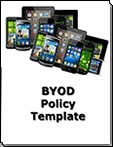BYOD Policy Setting Matrix
 BYOD Policy Matrix is the basis for a customized policy
BYOD Policy Matrix is the basis for a customized policy
BYOD (Bring Your Own Device) - is no longer the exception. Now it is the norm.
In establsihing a policy there are eight (8) factors to consider:
- Device Choice
- User Experience and Provacy
- Trust Model
- Application Design and Goveernance
- Liability
- Economics
- Sustainability
- Internal Marketing
The process for creating a BYOD Policy that works in a customized environment is driven by the Matrix below
Device Choice |
User Experience and Privacy |
- Analyzing employee preference and understanding which devices they have already bought
- Defining an acceptable baseline of what security and supportability features a bring-your-own-device program should support
- Understanding the operating system, hardware, and regional variances around that baseline
- Developing a light-touch certification plan for evaluation of future devices
- Establishing clear communication to users about which devices are allowed or not, and why
- Ensuring the IT team has the bandwidth to stay up-to-date
|
- Identifying the activities and data IT will monitor
- Clarifying the actions IT will take and under which circumstances
- Defining the BYOD privacy policy
- Critically assessing security policies and restrictions for sustainability
- Deploying core services (email, critical apps, WLAN access) to the employee
- Preserving the native experience
- Communicating compliance issues clearly to the employee
|
Trust Model |
App Design and Governance |
- Identifying and assessing risk for common security posture issues on personal devices
- Defining remediation options (notification, access control, quarantine, selective wipe)
- Setting tiered policy
- Establishing the identity of user and device
- Lending a critical eye to the sustainability of the security policy being instituted
|
- Designing mobile apps to match the trust level of personal devices
- Modifying app catalog availability based on device ownership
- Committing to the resource investment of building apps with personal devices in mind
- Updating app acceptable-use policies
- Defining enforcement levels for app violations (notification, access control, quarantine, or selective wipe
|
Liability |
Economics |
- Defining the elements of baseline protection for enterprise data on BYOD devices
- Assessing liability for personal web and app usage
- Assessing liability for usage onsite vs. offsite, and inside work hours vs. outside work hours
- Evaluating whether the nature of BYOD reimbursement affects liability (partial stipend vs. full payment of service costs)
- Quantifying the monitoring, enforcement and audit costs of the BYOD compliance policy
- Assessing the risk and resulting liability of accessing and damaging personal data (for example, doing a full instead of selective wipe by mistake)
|
- Shifting the cost of device hardware to the user and moving to a stipend model
- Controlling excess service charges through more responsible usage
- Establishing appropriate service plans, realizing some negotiating leverage might be lost
- Assessing the productivity impact of users being able to use their desired platforms
- Changing the help desk model (with BYOD, employees use the help desk as the last resort instead of a first resort)
- Reducing compliance and audit costs, if the legal assessment shows lower liability with personal devices)
- Assessing tax Implications
|
Sustainability |
Internal Marketing |
- Securing corporate data
- Minimizing the cost of implementation and enforcement
- Preserving the native user experience
- Staying up-to-date with user preferences and technology innovations
|
- Communicating why the company is moving to BYOD
- Understanding BYOD is an HR initiative as much as an IT initiative
- Defining IT's "brand"
- Supporting the brand message with appropriate action
|
Read on BYOD Policy Order BYOD Policy Download Selected Pages
 BYOD Policy Matrix is the basis for a customized policy
BYOD Policy Matrix is the basis for a customized policy